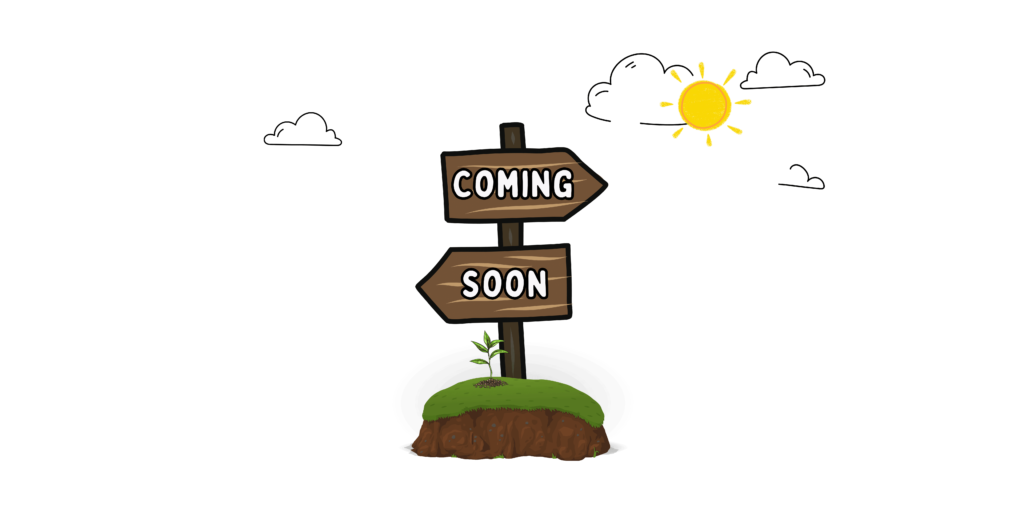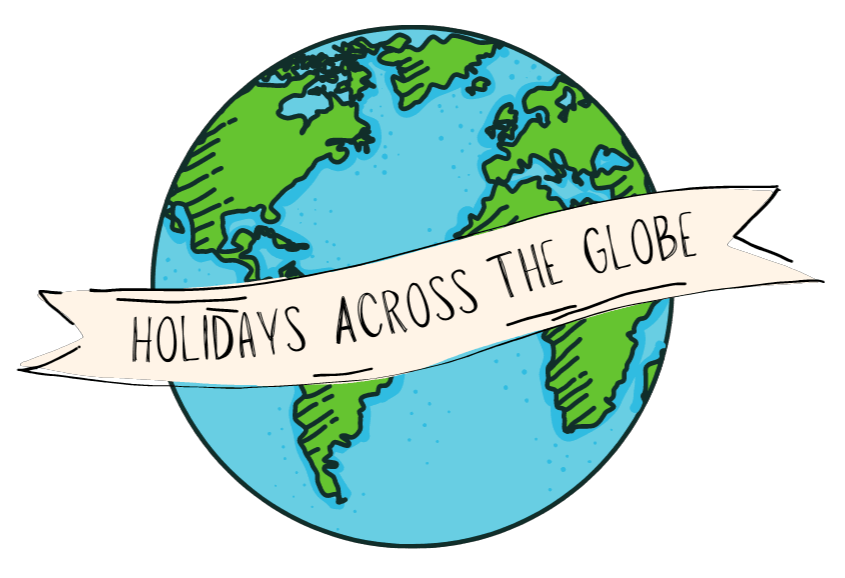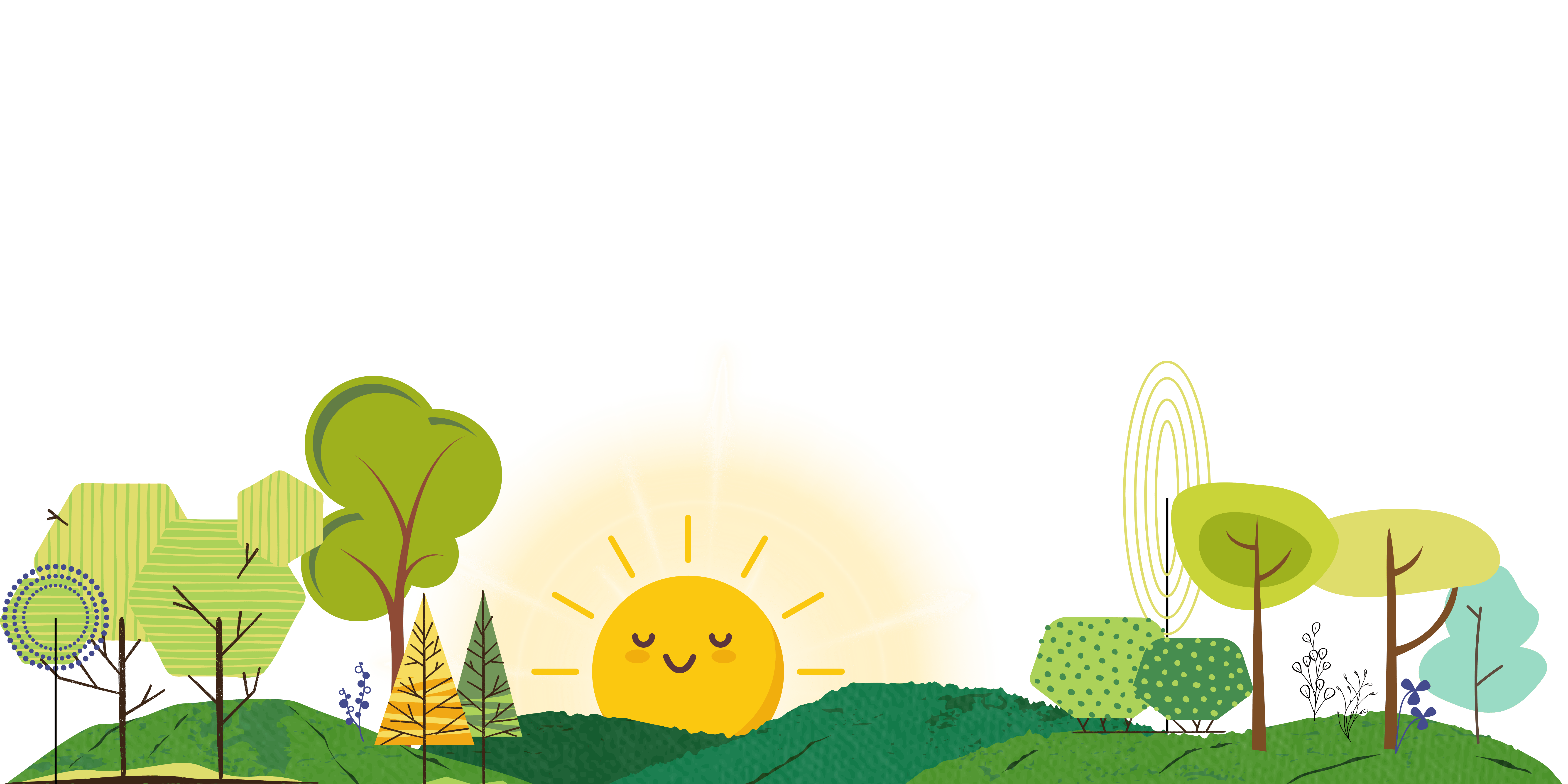
Recommended for readers ages 4-6 years old.
Celebrations Around the World: The Fabulous Celebrations you Won't Want to Miss
Marvel at a camel marathon amid the festivities of the Sahara Desert, savor the delight of indulging in delectable dumplings during Chinese New Year. Uncover the meaning behind the dancing skeletons at Mexico’s Day of the Dead and revel in the vibrant chaos of Holi, the Hindu Festival of Colors.
Recommended for readers ages 4-8 years old.
Feasts and Festivals Around the World: From Lunar New Year to Christmas
Across the world, people are joyously celebrating various festivals. Embark on a global festival journey, from South Korea to Nigeria to the USA! Experience Christmas in the summer with beach barbecues in Australia or immerse yourself in Thailand’s renowned Songkran, the vibrant Buddhist water festival. The seamless blend of rhyming text and captivating graphic illustrations beckons young readers to explore the diversity of cultures worldwide.
Recommended for readers ages 8-12 years old.
Celebrate with Me!: Recipes, Crafts, and Holiday Fun from Around the World
If you are looking for a book that invites families to partake in a tapestry of parties, festivals, and holidays. Each page unveils a unique celebration, presenting a step-by-step recipe, a craft activity, and various ways to observe the holiday. Featured celebrations include
New Years
Fun Facts
- One of the earliest recorded New Year celebrations can be traced back to ancient Mesopotamia around 2000 BCE. The Babylonians celebrated the New Year with an eleven-day festival, marking the first new moon after the vernal equinox.
- In ancient Rome, the early Roman calendar designated March 1 as the beginning of the new year. However, this changed when the Julian calendar was introduced by Julius Caesar in 45 BCE, moving the start of the year to January 1.
- Not all cultures celebrate the New Year on January 1. Some cultures, such as the Jewish community, celebrate Rosh Hashanah in the fall, while others, like the Islamic calendar, follow a lunar calendar, shifting the New Year date each year.
Pongal
Fun Facts
- Pongal is a four-day festival, and each day has its own significance. The first day is Bhogi Pongal, followed by Thai Pongal, Maatu Pongal, and Kaanum Pongal.
- The dish “Pongal” is a sweet rice and lentil porridge cooked with jaggery, milk, and ghee. It is traditionally prepared in a clay pot, and the boiling over of the pot is considered a symbol of prosperity.
- The festival emphasizes environmental sustainability. On the fourth day, known as Kaanum Pongal, people visit riverbanks and scenic spots, promoting a connection with nature.
Chinese New Year
Fun Facts
- Colorful lion and dragon dances are common during Chinese New Year parades and celebrations. The lion dance is believed to bring good luck and drive away evil spirits, while the dragon dance symbolizes power and prosperity.
- Red is the predominant color during Chinese New Year as it is associated with good luck and happiness. Homes and streets are adorned with red lanterns, banners, and other decorations to usher in positive energy.
- Chinese New Year celebrations extend over a 15-day period, culminating in the Lantern Festival. Each day is associated with different customs and traditions.
- The eve of Chinese New Year is celebrated with a reunion dinner, where families come together to share a festive meal. It is considered one of the most important meals of the year, emphasizing the importance of family unity.
Vietnamese New Year - Tet Nguyen Dan
Fun Facts
- Tet is the longest and most important holiday in Vietnam, spanning about seven days. It is a time for family reunions, honoring ancestors, and expressing good wishes for the coming year.
- Similar to other Asian cultures, red and gold are prominent colors during Tet. Red symbolizes good luck, while gold represents wealth and prosperity. Homes are adorned with red banners, flowers, and traditional ornaments.
- Tet is divided into three main days: “Tet Nguyen Dan” (New Year’s Eve), “Tet” (the first day of the New Year), and “Tet Tan Nien” (the next days of the New Year). Each day has its own set of customs and traditions.
Valentine's Day
Fun Facts
- While celebrated globally, the way Valentine’s Day is observed varies. In Japan, it is customary for women to give chocolates to men on Valentine’s Day, while in South Korea, both men and women exchange gifts on February 14th and March 14th.
- The tradition of exchanging Valentine’s Day cards became popular in the 17th century in England. Today, it is estimated that over a billion cards are exchanged each year, making it the second-largest card-sending holiday after Christmas.
- Red and pink are the traditional colors of Valentine’s Day. Red symbolizes love and passion, while pink represents affection and sweetness.
Recommended Videos
- Valentine’s Day Special
- Making A Card For My Valentine
- Valentines Day | Llama Llama Episode
- Valentine’s Day on Sesame Street!
A Little Spot of Love
- [The Content Below is For Older Children]
- Valentine’s Day Facts
- How Did Valentine’s Day Start?
- 10 DIY Valentine’s Day Craft Ideas
- Valentine’s Day Craft for Kids
Lent
Fun Facts
- Lent is a 40-day period, not counting Sundays, that begins on Ash Wednesday and ends on Holy Saturday. The number 40 has biblical significance, representing preparation, testing, and renewal.
- Purple is the traditional color associated with Lent, symbolizing penance, mourning, and preparation. It reflects the somber and reflective nature of the season.
- Lent is traditionally a time of fasting, self-examination, and penance. Many choose to give up a specific indulgence or habit during this period and may also abstain from certain foods.
Saint Patrick's Day
Fun Facts
- St. Patrick was not originally from Ireland. He was born in Britain, captured by Irish raiders, and later became a missionary in Ireland.
- St. Patrick is often associated with the shamrock, a three-leaved plant. Legend has it that he used the shamrock to explain the concept of the Holy Trinity (Father, Son, and Holy Spirit) to the Irish.
- Blue, not green, was the original color associated with St. Patrick. Over time, green became the more popular color, symbolizing Ireland’s lush landscape.
Ramadan
Fun Facts
- Different cultures and regions have unique traditions and customs during Ramadan, reflecting the rich diversity within the Muslim community. Each culture brings its own flavors to the iftar meals and special dishes.
- Ramadan emphasizes community and charity. Muslims are encouraged to strengthen bonds with family and friends and to engage in acts of kindness and charity, such as providing iftar meals for those in need.
- Ramadan is considered the holiest month in Islam because it is believed that the Quran, the holy book of Islam, was revealed to Prophet Muhammad during this month.
April Fools Day
Fun Facts
- April Fools’ Day is celebrated in many countries around the world, although the customs and traditions may vary. It is often known by different names, such as “April Fish” in France. Children tape a paper fish to their friends’ backs as a prank.
- The exact origins of April Fools’ Day are unclear, and there are various theories about how the tradition began. Some believe it dates back to the switch from the Julian to the Gregorian calendar in the 16th century when New Year’s Day moved from late March or early April to January 1st.
- In some countries, April Fools’ pranks are traditionally played only until noon. After noon, the prankster becomes the “April fool,” and it’s considered bad luck to play pranks later in the day.
Passover
Fun Facts
- Passover is celebrated by Jewish communities worldwide, each with its own unique customs and traditions. The central theme of freedom and liberation remains constant.
- The traditional greeting during Passover is “Chag Sameach,” which means “Happy Holiday” in Hebrew.
- The middle matzah at the Seder is broken in half, and one piece, called the afikoman, is hidden. Children then search for it, and its discovery often results in a reward. The afikoman is later eaten as the final part of the meal.
Recommended Videos
[The Content Below is For Older Children]
Easter
Fun Facts
- Different cultures have various traditional foods for Easter. In many places, lamb is a common Easter dish, symbolizing the Lamb of God in Christian theology. Hot cross buns are also a traditional Easter treat.
- Easter is celebrated differently across cultures. In Greece, for example, the tradition of “Anastasi” involves midnight church services and the breaking of a fast with a special meal. In Sweden and Finland, children dress up as Easter witches and exchange drawings for treats.
- In Eastern European countries like Poland and Hungary, it is a tradition to drench each other with water on Easter Monday. This custom is believed to symbolize cleansing and renewal.
- The Easter Bunny is a popular symbol of Easter. The tradition is believed to have originated in Germany, where children believed that a hare would lay eggs for them to find.
Recommended Videos
[The Content Below is For Older Children]
Earth Day
Fun Facts
- Earth Day is now celebrated in over 190 countries, making it one of the largest environmental events in the world.
- In some cities, iconic landmarks and buildings participate in “Lights Out” campaigns for Earth Day. They turn off non-essential lighting to raise awareness about energy conservation.
- Each year, Earth Day has a specific theme. Themes have ranged from climate action and environmental education to protecting endangered species.
Cinco de Mayo
Fun Facts
- Contrary to popular belief, Cinco de Mayo does not mark Mexican Independence Day. Mexico’s Independence Day is celebrated on September 16th.
- Cinco de Mayo has evolved into a celebration of Mexican culture, featuring music, dance, traditional food, and parades. It provides an opportunity for people to appreciate and enjoy Mexican customs.
- While Cinco de Mayo is celebrated across Mexico, it holds special significance in the city of Puebla, where the historic battle took place. The city hosts parades, reenactments, and other events to commemorate the victory.
Kodomo-no-hi
Fun Facts
- Originally, Japan had separate festivals for boys (Tango no Sekku) and girls (Hinamatsuri). After World War II, these were combined into Kodomo-no-hi, which celebrates the well-being of all children.
- Kodomo-no-hi is not just a day for festivities but also a day to express hope for children’s happiness, health, and success in the future.
- The carp streamers come in various colors, each representing a family member. Black is for the father, red or pink for the mother, and additional colors for each child.
Mother's Day
Fun Facts
- Different countries have unique ways of celebrating Mother’s Day. In Mexico, for example, Mother’s Day is a big holiday with parades and festivities. In Japan, it is common to gift flowers, particularly carnations.
- Mother’s Day is one of the busiest days for restaurants, with many families choosing to celebrate by dining out.
- Mother’s Day is the third-largest card-sending holiday in the United States, following Christmas and Valentine’s Day. Millions of cards are exchanged each year.
Recommended Videos
Memorial Day
Fun Facts
- The red poppy flower has become a symbol of remembrance for fallen soldiers. This tradition originated from the World War I poem “In Flanders Fields” by Lieutenant Colonel John McCrae.
- On Memorial Day, the U.S. flag is raised briskly to the top of the staff and then solemnly lowered to half-staff until noon. After noon, it is raised to full-staff for the remainder of the day.
- Some people choose to wear blue on Memorial Day as a way to honor the fallen and show support for military families.
Juneteenth
Fun Facts
- Juneteenth has its origins in Galveston, Texas. On June 19, 1865, Union General Gordon Granger arrived in Galveston and read General Order No. 3, announcing that all slaves in Texas were free.
- While President Abraham Lincoln issued the Emancipation Proclamation on January 1, 1863, declaring slaves in Confederate-held territory free, it took more than two years for the news to reach Texas.
- Red, white, and blue are commonly associated with Juneteenth, symbolizing freedom and American heritage. The Juneteenth flag, designed by Ben Haith, features a bursting star in the center, a nod to Texas, and a broken chain representing liberation.
Father's Day
Fun Facts
- The idea of Father’s Day is often credited to Sonora Smart Dodd, who wanted to create a day to honor fathers like her own single father. The first Father’s Day was celebrated on June 19, 1910, in Spokane, Washington. Sonora Dodd’s father, William Jackson Smart, was a Civil War veteran and a single parent who raised six children.
- While the first Father’s Day was celebrated in 1910, it wasn’t until 1972 that Father’s Day became a nationwide holiday in the United States. President Richard Nixon signed it into law.
- In the early years of Father’s Day, fathers were encouraged to take the day off from work and spend it with their families.
Canada Day
Fun Facts
- The maple leaf is a prominent symbol of Canada and is featured on the national flag. Many Canada Day celebrations incorporate maple leaf imagery and decorations.
- Canada Day was originally known as Dominion Day and commemorated the day Canada became a self-governing dominion within the British Empire in 1867.
- Traditional Canadian foods are often enjoyed on Canada Day. This may include poutine, butter tarts, Nanaimo bars, and, of course, a barbecue with Canadian-grown meats.
Recommended Videos
U.S. Independence Day
Fun Facts
- The Continental Congress declared independence from British rule by adopting the Declaration of Independence on July 4, 1776. The document was primarily authored by Thomas Jefferson.
- John Adams, one of the Founding Fathers and later the second President of the United States, wrote to his wife Abigail that July 2nd would be celebrated as the most memorable day in American history. However, the final version of the Declaration was approved on July 4th.
- Independence Day is one of the largest hot dog consumption days in the United States. According to the National Hot Dog and Sausage Council, Americans consume over 150 million hot dogs on the Fourth of July.
World Humanitarian Day
Fun Facts
- World Humanitarian Day was established by the United Nations General Assembly in 2008. It commemorates the 2003 Canal Hotel bombing in Baghdad, Iraq, which killed 22 people, including the UN’s Special Representative for Iraq, Sergio Vieira de Mello.
- Each year, World Humanitarian Day has a specific theme. The themes often focus on the stories and experiences of humanitarian workers and the people they assist.
- World Humanitarian Day serves as an opportunity to recognize and honor the dedication and sacrifices of humanitarian workers, who often work in dangerous and challenging environments.
Labor Day
Fun Facts
- While Labor Day is celebrated in the U.S. on the first Monday of September, many other countries observe International Workers’ Day, also known as Labor Day, on May 1st.
- Labor Day originated from the labor union movement, and it is dedicated to the social and economic achievements of American workers.
- Labor Day became an official federal holiday in 1894 when President Grover Cleveland signed it into law.
Grandparents Day
Fun Facts
- Grandparents Day was officially recognized as a national holiday in the United States in 1978. President Jimmy Carter signed the proclamation, and it is celebrated on the first Sunday after Labor Day.
- The official flower of Grandparents Day is the forget-me-not. It symbolizes the lasting and loving relationships between generations.
- Grandparents Day serves as an opportunity to recognize and appreciate the positive influence that grandparents have on the lives of their grandchildren and the broader family unit.
Yom Kippur
Fun Facts
- Yom Kippur is considered the holiest day in the Jewish calendar. It follows the Ten Days of Repentance that begin with Rosh Hashanah, the Jewish New Year.
- Fasting is a central component of Yom Kippur observance. Jewish adults typically abstain from food, drink, and other physical needs for approximately 25 hours, from sunset to sunset.
- Yom Kippur emphasizes not only personal repentance but also social justice and charity. Jews are encouraged to engage in acts of kindness and charity during this time.
Columbus Day
Fun Facts
- Columbus Day became a federal holiday in 1937, with President Franklin D. Roosevelt signing it into law. It was initially celebrated on October 12 but was later moved to the second Monday of October.
- Much of what is known about Columbus’s voyages comes from his journals. He documented his observations, encounters, and thoughts throughout his exploration.
Recommended Videos
[The Content Below is For Older Children]
Diwali
Fun Facts
- Diwali is often referred to as the “Festival of Lights” because it is marked by the lighting of lamps, candles, and colorful decorations. The lights symbolize the victory of light over darkness and good over evil.
- Diwali usually takes place between October and November, depending on the lunar calendar. The festival spans five days, with the main celebration occurring on the third day.
- Rangoli, colorful and intricate patterns made on the ground using colored powders, rice, or flower petals, is a common Diwali tradition. It is believed to bring good luck and is a form of artistic expression.
Dia de los Muertos
Fun Facts
- Families create ofrendas (altars) in their homes to honor and remember the deceased. These altars are adorned with photographs, candles, flowers, favorite foods, and mementos of the departed.
- Sugar skulls are intricately decorated, colorful candies made in the shape of skulls. They often bear the names of deceased individuals and are placed on ofrendas as a sweet offering to the departed.
- Marigolds, known as cempasúchil in Mexico, are the traditional flowers used during Dia de los Muertos. They are believed to guide the spirits back to the world of the living.
- Papel picado, intricately cut paper banners, are commonly used to decorate homes and altars. They symbolize the fragility of life and the connection between the living and the dead.
Halloween
Fun Facts
- Wearing costumes on Halloween is thought to have originated from the Celtic practice of disguising themselves to avoid being recognized by spirits.
- Bats and black cats are often associated with Halloween. In medieval Europe, it was believed that witches could transform into black cats, and bats were seen as a symbol of the night.
- Halloween has ancient Celtic roots, with its origins believed to be in the Celtic festival of Samhain, which marked the end of the harvest season and the beginning of winter.
Veterans Day
Fun Facts
- Originally, Veterans Day was called Armistice Day and commemorated the end of World War I. The armistice between Germany and the Allied nations went into effect on the 11th hour of the 11th day of the 11th month in 1918.
- At 11:00 a.m. on Veterans Day, a moment of silence is observed to honor and remember veterans who have served and sacrificed for their country.
- The Veterans Day National Committee at the U.S. Department of Veterans Affairs designs a new seal each year for Veterans Day. The seal is used to promote the holiday and its meaning.
Thanksgiving
Fun Facts
- Canada also celebrates Thanksgiving, but it is observed on the second Monday in October. The Canadian Thanksgiving is more closely tied to the harvest season.
- Some Native American groups observe Thanksgiving as a National Day of Mourning, highlighting the impact of European colonization on indigenous peoples.
- President Abraham Lincoln issued a Thanksgiving proclamation in 1863, declaring Thanksgiving a national holiday. He set the date as the final Thursday in November.
Recommended Videos
- Thanksgiving Story for Kids
- Thanksgiving for Kids
- [The Content Below is For Older Children]
- The Real Story Of Thanksgiving
- Thankfulness Tree Craft For Kids
- TURKEY POP UP CARD
- 3 Turkey Craft Ideas for Thanksgiving
Chanukah - Hanukkah
Fun Facts
- Hanukkah is often referred to as the Festival of Lights. This name originates from the miracle of the menorah, where a single day’s worth of oil lasted for eight days during the rededication of the Second Temple in Jerusalem.
- Giving and receiving chocolate coins, known as gelt, is a common Hanukkah tradition. It symbolizes both the historical significance of coins and the act of giving.
- Blue and white are the traditional colors associated with Hanukkah, representing the blue sky and white snow.
Bodhi Day
Fun Facts
- “Bodhi” is a Sanskrit term that translates to “awakening” or “enlightenment.” In Buddhism, it specifically refers to the awakening and realization of the true nature of reality.
- The Bodhi Tree holds immense importance in Buddhism. It is under this tree that Siddhartha Gautama, later known as Buddha, attained enlightenment. The tree is located in Bodh Gaya, India.
- The concept of Bodhi has had a profound influence not only in Asia but also globally, as interest in mindfulness, meditation, and spiritual awakening has grown across cultures and traditions.
Christmas
Fun Facts
- The tradition of decorating Christmas trees originated in 16th century Germany. Martin Luther is often credited with adding candles to trees, inspired by the beauty of stars shining through the evergreen branches.
- In some cities, iconic landmarks and buildings participate in “Lights Out” campaigns for Earth Day. They turn off non-essential lighting to raise awareness about energy conservation.
- The first Christmas card was sent in 1843 by Sir Henry Cole, a British civil servant. The card featured a festive scene and the message “A Merry Christmas and a Happy New Year to You.”
Recommended Videos
- Gingerbread House | Kids Songs
- How CHRISTMAS Started ?
- George’s Merry Little Christmas
- Christmas History for Kids
- Why Do We Have Christmas Trees?
- The History of Christmas
- Animated Bible Story for Kids
- The Christmas Story, As Told By Children
- Sock Snowman in 10 Minutes
- Christmas Crafts for Kids
- Christmas Cards Ideas
- DIY Christmas tree
Kwanzaa
Fun Facts
- Kwanzaa is celebrated from December 26th to January 1st, lasting for seven days. Each day is dedicated to one of the seven principles (Nguzo Saba) of Kwanzaa.
- Each day of Kwanzaa, a candle is lit on the Kinara to represent one of the seven principles. The black candle represents Umoja (Unity), and each subsequent day, a new candle is lit, alternating between red and green.
- The colors of Kwanzaa are black, red, and green. Black represents the people, red symbolizes their struggle, and green represents the future and hope.
More Content Coming Soon
At Brainy and Nimble, we are dedicated to providing comprehensive educational resources. Additional grade levels and enriching content are in the pipeline. Stay tuned for our upcoming additions as we continue to expand our offerings and support learners at every stage of their educational journey.

Please note that this website contains affiliate links, through which I earn a small commission from any purchases made. While it is not mandatory to use these links, your support is always greatly appreciated as these funds help support the maintenance and development of this website.
This commission comes at no additional cost to you.







 Earth Day
Earth Day World Humanitarian Day for Kids | 19 August | Humanitarian Examples
World Humanitarian Day for Kids | 19 August | Humanitarian Examples  Have You Filled A Bucket Today?-Read Aloud Book
Have You Filled A Bucket Today?-Read Aloud Book